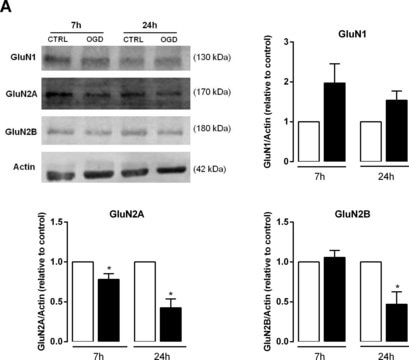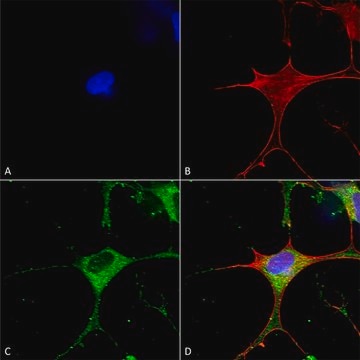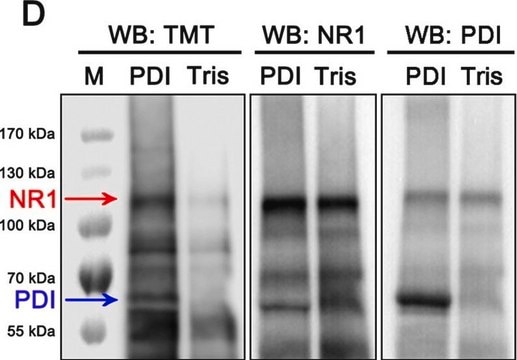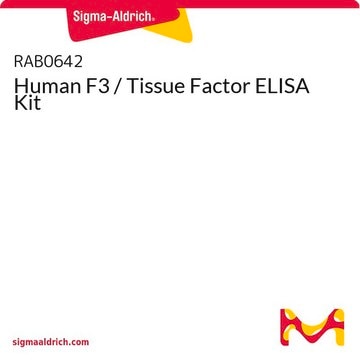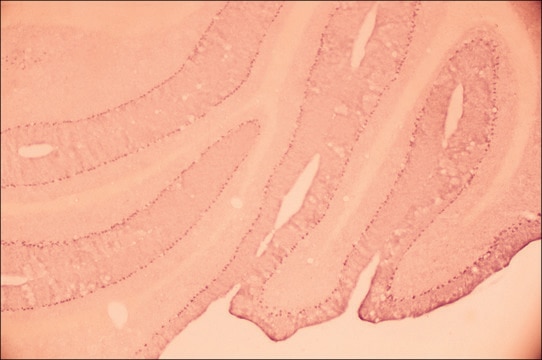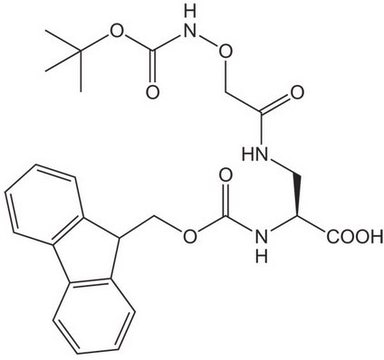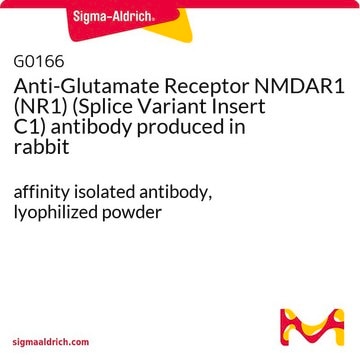AB5046P
Anti-NMDAR1 Splice Variant C1 Antibody
Chemicon®, from rabbit
Sign Into View Organizational & Contract Pricing
All Photos(1)
About This Item
UNSPSC Code:
12352203
eCl@ss:
32160702
NACRES:
NA.41
Recommended Products
biological source
rabbit
Quality Level
antibody form
affinity purified immunoglobulin
antibody product type
primary antibodies
clone
polyclonal
purified by
affinity chromatography
species reactivity
rat
packaging
antibody small pack of 25 μg
manufacturer/tradename
Chemicon®
technique(s)
western blot: suitable
NCBI accession no.
UniProt accession no.
shipped in
dry ice
target post-translational modification
unmodified
Gene Information
rat ... Grin1(24408)
Specificity
Specific for the NMDAR1 C1 splice variant. AB5046P recognizes the C1 splice insert present in NR1 variants, 1a, 1b, 3a and 3b. {Gorter et al, (1997), "The Role of Alternative Splicing of the NMDAR1 Receptor Subunit in Synaptic Plasticity" Chapter 4, pg 99, in The Ionotropic Glutamate Receptors , Monaghan, D.T. and Weinhold, R.J. (eds), Humana Press, New Jersey) By Western blot the antibody recognizes a protein with molecular weight of 100 kDa.
Immunogen
Peptide corresponding to the C-terminus of the rat NMDAR1 C1 splice variant.
Application
Anti-NMDAR1 Splice Variant C1 Antibody is an antibody against NMDAR1 Splice Variant C1 for use in WB.
Research Category
Neuroscience
Neuroscience
Research Sub Category
Neurotransmitters & Receptors
Neurotransmitters & Receptors
Western blot: 1:1,000 using ECL on rat brain lysate.
Immunohistochemistry: 1:1,000.
Optimal working dilutions must be determined by the end user.
Immunohistochemistry: 1:1,000.
Optimal working dilutions must be determined by the end user.
Physical form
Affinity purified immunoglobulin. Lyophilized from ammonium bicarbonate (5 mM) so some residual salt may also be present. Reconstitute with 50 μL of PBS. Contains no preservatives.
Storage and Stability
Maintain at -20°C in undiluted aliquots for up to 6 months. Avoid repeated freeze/thaw cycles.
Legal Information
CHEMICON is a registered trademark of Merck KGaA, Darmstadt, Germany
Disclaimer
Unless otherwise stated in our catalog or other company documentation accompanying the product(s), our products are intended for research use only and are not to be used for any other purpose, which includes but is not limited to, unauthorized commercial uses, in vitro diagnostic uses, ex vivo or in vivo therapeutic uses or any type of consumption or application to humans or animals.
Not finding the right product?
Try our Product Selector Tool.
wgk_germany
WGK 1
Certificates of Analysis (COA)
Search for Certificates of Analysis (COA) by entering the products Lot/Batch Number. Lot and Batch Numbers can be found on a product’s label following the words ‘Lot’ or ‘Batch’.
Already Own This Product?
Find documentation for the products that you have recently purchased in the Document Library.
K D Holmes et al.
Journal of neurochemistry, 81(6), 1152-1165 (2002-06-18)
The N -methyl-D-aspartate receptor (NMDAR) is a multimeric transmembrane protein composed of at least two subunits. One subunit, NR1, is derived from a single gene and can be subdivided into three regions: the N-terminal extracellular domain, the transmembrane regions, and
Israel Pichardo-Casas et al.
Brain research, 1436, 20-33 (2011-12-27)
In recent years, microRNAs or miRNAs have been proposed to target neuronal mRNAs localized near the synapse, exerting a pivotal role in modulating local protein synthesis, and presumably affecting adaptive mechanisms such as synaptic plasticity. In the present study we
Expression of the Hippocampal NMDA Receptor GluN1 Subunit and Its Splicing Isoforms in Schizophrenia: Postmortem Study.
Vrajova, Monika, et al.
Neurochemical Research (2010)
H Monyer et al.
Science (New York, N.Y.), 256(5060), 1217-1221 (1992-05-22)
The N-methyl D-aspartate (NMDA) receptor subtype of glutamate-gated ion channels possesses high calcium permeability and unique voltage-dependent sensitivity to magnesium and is modulated by glycine. Molecular cloning identified three complementary DNA species of rat brain, encoding NMDA receptor subunits NMDAR2A
Our team of scientists has experience in all areas of research including Life Science, Material Science, Chemical Synthesis, Chromatography, Analytical and many others.
Contact Technical Service